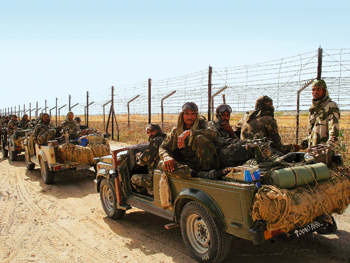INDIAN ARMED FORCES CHIEFS ON OUR RELENTLESS AND FOCUSED PUBLISHING EFFORTS

The insightful articles, inspiring narrations and analytical perspectives presented by the Editorial Team, establish an alluring connect with the reader. My compliments and best wishes to SP Guide Publications.

"Over the past 60 years, the growth of SP Guide Publications has mirrored the rising stature of Indian Navy. Its well-researched and informative magazines on Defence and Aerospace sector have served to shape an educated opinion of our military personnel, policy makers and the public alike. I wish SP's Publication team continued success, fair winds and following seas in all future endeavour!"

Since, its inception in 1964, SP Guide Publications has consistently demonstrated commitment to high-quality journalism in the aerospace and defence sectors, earning a well-deserved reputation as Asia's largest media house in this domain. I wish SP Guide Publications continued success in its pursuit of excellence.
- Operation Sindoor: Resolute yet Restrained
- India’s Operation Sindoor Sends a Clear Message to Terror and the World – ‘ZERO TOLERANCE’
- Japan and India set forth a defence cooperation consultancy framework, talks on tank and jet engines
- Terrorist Attack in Pahalgam in Kashmir: Unfolding a long surgical war against PAK
- Lt General Pratik Sharma takes over Command of Indian Army's Northern Command
Border Management
 |
By Lt. General P.C. Katoch (Retd) Former Director General of Information Systems, Indian Army |
India is surrounded by countries with increasing instability. The nature and type of our borders makes facilitates this instability to transcend trans-border, a recent example being the Burdwan blasts and the JMB conspiracy to topple the government in Bangladesh. It is also well established that political nexus for illegal immigration from Bangladesh has been on several years for vote bank politics, in addition to smuggling of weapons, narcotics, goods and food items. This goes for other borders as well. With increasing mobility of people and goods, organized crime groups are making use of easy and convenient trans-border access to commit crimes, increasing the priority for border security management.

Perpetrators of terrorism; trafficking in human beings, arms and drugs; environmental crime; fraud; identity theft and many other types of crime continuously change their modus operandi to avoid detection by national law enforcement agencies, but many of these crimes involve the physical crossing of a border by people or goods. A coordinated approach is therefore essential to eliminate duplication of mechanisms and efforts and to improve border security managements. It was revealed during the 2012 World Economic Forum that the cross-border flow of global proceeds from criminal activities, corruption and tax evasion is estimated at over US$ 1 trillion while illegal drugs and counterfeit goods each account for eight per cent of the world trade. According to (Frost & Sullivan Global Border and Maritime Security Market Assessment, 2013):
- The global border security market size was US$ 16.3 billion in 2012, which is expected to increase to US$ 32.5 billion by 2021;
- The intelligence, surveillance and reconnaissance segment will contribute more than 40 per cent to this market by 2021, and;
- The fragmented market of border security relying on human-intensive technique like lookout posts, guards, or paramilitaries is set to change in the period mentioned with technology adoption and better ISR solutions available in the market. India has land borders totalling some 15,072 kms;
3,431 kms with Pakistan, 5,852 kms with China-Nepal-Bhutan, 1,452 kms with Myanmar and 4,337 kms with Bangladesh. Length of our coastline is 7,863 kms. Our difficult and porous borders are repeatedly being subjected to infiltration, terror, cross border attacks and illegal demographic invasion. We face multiple problems in border management like; inhospitable terrain, weather, snows; lack of obstacles; border only partly fenced; fence buried in snow, damaged in avalanches and gaps blown by infiltrators; farming and habitation right up to border in some areas; lack of border infrastructure; large barren tracts along some border areas; proxy wars by Pakistan and China – assisting infiltration; lack of surveillance and communication facilities; politician-terrorists-narcotics mafia nexus; illegal immigration, arms, drug flow from Bangladesh and Myanmar; multiple forces, multiple channels of command, and; border villages in some areas patronized by enemy. J&K is a different kettle of fish altogether where NIA reports confirm trans-border nexus for infiltration, terrorism and money laundering. Last October, PM Modi had stated, .. we are facing a future where situations will evolve and change swiftly; and, technological changes will make responses more difficult …the enemy may be invisible.” We have been engaged in asymmetric wars over past three decades and we cannot be lax in matters of security - there cannot be scope of any break in downtime. We need a 24x7 warning cum surveillance system through a network of a variety of sensors (surface, sub-surface and in the air), cameras etc that are digitally connected to give a live picture. The aim should be best possible advance warning and capability to respond effectively. In wake of speedy technological advancements, C4I2SR systems provide sterling opportunities for the defence and security establishment acting as important force multiplier for border management. We need a networked Security Sector aiming at information dominance with technology providing numerous options to build automated C4I2 systems for effective response in modern security related situations including border management. We need to progressively develop foolproof security at our borders and comprehensive security of all vulnerable points and vulnerable areas against threats of all types. The challenge is to harness the power of sensors, information processing and communication technologies to develop concepts of operation and command and control approaches that will ensure comprehensive all round security in any given situation or circumstance.





